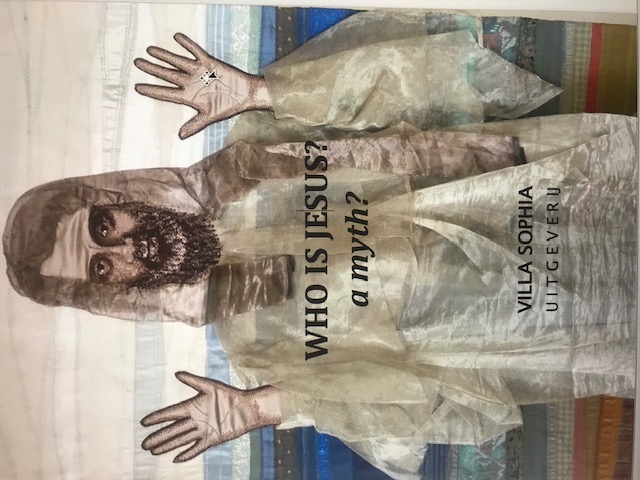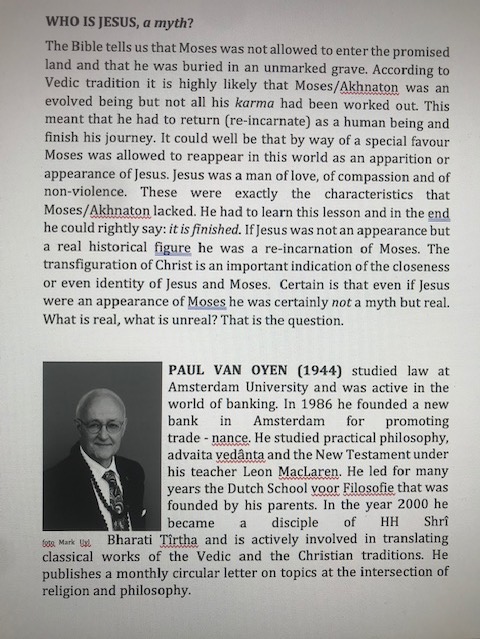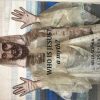Who is Jesus?
€ 20,00
a myth?
Oyen, Paul van | Paperback / softback | 26-05-2020 | 9789076392479
WHO IS JESUS, a myth?
The Bible tells us that Moses was not allowed to enter the promised land and that he was buried in an u…
a myth?
Oyen, Paul van | Paperback / softback | 26-05-2020 | 9789076392479
WHO IS JESUS, a myth?
The Bible tells us that Moses was not allowed to enter the promised land and that he was buried in an unmarked grave. According to Vedic tradition it is highly likely that Moses/Akhnaton was an evolved being but not all his karma had been worked out. This meant that he had to return (re-incarnate) as a human being and finish his journey. It could well be that by way of a special favour Moses was allowed to reappear in this world as an apparition or appearance of Jesus. Jesus was a man of love, of compassion and of non-violence. These were exactly the characteristics that Moses/Akhnaton lacked. He had to learn this lesson and in the end he could rightly say: it is finished. If Jesus was not an appearance but a real historical figure he was a re-incarnation of Moses. The transfiguration of Christ is an important indication of the closeness or even identity of Jesus and Moses. Certain is that even if Jesus were an appearance of Moses he was certainly not a myth but real.
What is real, what is unreal? That is the question.
Foreword
It seems that the debate round the identity of Jesus has not come to rest yet, even after two thousand years. This essay by Paul van Oyen demonstrates that new perspectives can still be discovered. He proposes two major new views of the figures of Jesus and of Moses and explains how they are closely related.
Who was Jesus, a historical figure, a mythical figure, or a figment of our imagination? Over the centuries every aspect of this subject has been studied and written about, but without a conclusive answer, and there may never be one. This is because there are a great number of contradictory and ambiguous statements in the Bible regarding the historical events around Jesus, which cannot therefore serve as reliable evidence. Nevertheless, this has not prevented Paul van Oyen from having a go at unravelling the mystery round the figures of Jesus and Moses, and he has taken a rather unconventional route to support his conclusion.
Paul van Oyen, as well as a number of other scholars believe that, between twelve and thirty years of age (the so-called unknown years) Jesus lived in India. It is thought that he received spiritual instruction there and became a great Yogi, preparing him for the last three years of his life in Palestine. Following that train of thought the author proposes that Jesus was a re-incarnation of Moses. The term re-incarnation was well known in biblical times, but was eradicated from the New Testament by Emperor Constantine in the 4th C, leaving only a few references to it in the Bible. To support his view the author found twenty striking parallels between Moses and Jesus:
Here is one:
Then Moses stretched out is hand over the sea, and the Lord drove the sea back by a strong east wind all night and made the sea dry land and the waters were divided.
Exodus 14, 21
And they went and woke him saying, “Save us, Lord; we are perishing.” And he said to them: “Why are you afraid, O you of little faith?” Then he rose and rebuked the winds and the sea, and there was a great calm. And the man marveled, saying, “What sort of man is this, that even winds and sea obey him?
Matthew 8, 25-27
Significantly, in the transfiguration of Christ, it is Moses and Elijah who stand on either side of Jesus. The author regards Elijah to be the fore runner of John the Baptist and Moses of Christ.
With regard to Moses, Paul van Oyen proposes and reasons that Moses could be the same person as the Pharaoh Akhnaton, who lived in the 14th c. B.C. Apparently, no one has yet considered that Moses (born around 1395 BC) is the family name of the 18th Dynasty of Egyptian Pharaohs with such names as Tutmoses I, II, III, IV, while the older brother of Akhnaton also bore the name “Tuthmoses”.
Paul van Oyen has to be admired for his attempt to reopen the debate with what may be to some an unorthodox proposition. However, to others it could be food for thought and a welcome eyeopener to an age-old mystery.
Dorine Tolley
| Gewicht | 0,182 kg |
|---|---|
| Afmetingen | 19,9 × 14,9 × 0,8 cm |
| Taal | Engels |
| Uitvoering | Paperback / softback |
| Auteur | Oyen, Paul van |
| Verschijningsjaar | 2020 |
| ISBN | 9789076392479 |







